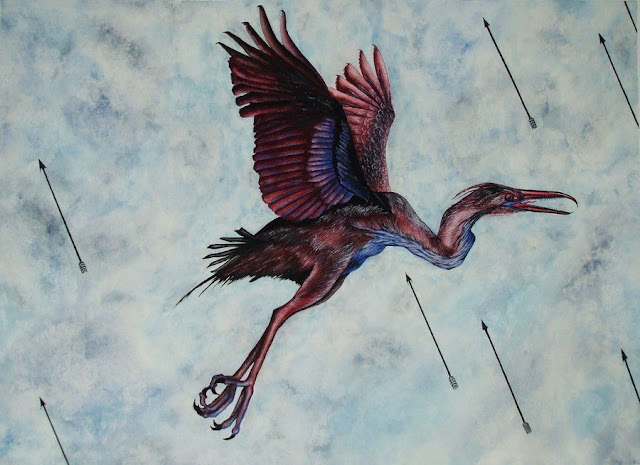The Stymphalian birds were a group of monstrous birds in Greek mythology. They devoured humans, and had beaks made of bronze. Their feathers were sharp and metallic and could be thrown against their prey, while their dung was poisonous. They fly against those who come to hunt them, wounding and killing them with their beaks. All armour of bronze or iron that men wear is pierced by the birds; but if they weave a garment of thick cork, the beaks of the Stymphalian birds are caught in the cork garment, just as the wings of small birds stick in bird-lime. These birds are of the size of a crane, and are like the ibis, but their beaks are more powerful, and not crooked like that of the ibis.
They were created by the god of war, Ares, and were hunted down by wolves; to escape, the birds reached the lake Stymphalia in the Greek region of Arcadia, where they reproduced quickly and destroyed farmlands and the countryside.
Killing the Stymphalian birds was the sixth task that was appointed to the demigod hero Heracles during the myth of the Labours of Heracles. King Eurystheus asked him to kill the birds, hoping that the hero would fail. The land around the lake was a marsh and Heracles could not step safely there in order to reach the nests. So, the goddess Athena, wanting to help him, gave him a rattle that the blacksmith god Hephaestus had specifically made for this occasion. Heracles used the rattle and scared the birds which abandoned their nests and started flying. He then shot most of them down using arrows which he had previously dipped into the poisonous blood of the monster Hydra. The remaining birds flew away, abandoning Arcadia and reaching an island in the Euxine Sea. They were encountered later by the Argonauts.
SISYPHUS, son of Aeolus, married Atlas ’s daughter Merope, the Pleiad, who bore him Glaucus , Ornytion , and Sinon, and owned a fine herd of cattle on the Isthmus of Corinth. b. Near him lived Autolycus , son of Chione , whose twin-brother Philammon was begotten by Apollo , though Autolycus himself claimed Hermes as his father. c. Now, Autolycus was a past master in theft, Hermes having given him the power of metamorphosing whatever beasts he stole, from horned to unhorned, or from black to white, and contrariwise. Thus although Sisyphus noticed that his own herds grew steadily smaller while those of Autolycus increased, he was unable at first to accuse him of theft; and therefore, one day, engraved the inside of all his cattle’s hooves with the monogram SS or, some say, with the words ‘Stolen by Autolycus’. That night Autolycus helped himself as usually and at dawn hoof-prints along the road provided Sisyphus with sufficient evidence to summon neighbours in witness of the th...

Comments
Post a Comment